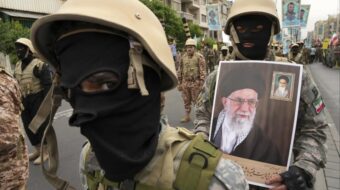As if two wars weren’t enough, new war clouds are gathering over the Middle East. With the Afghanistan war still going full tilt, and that in Iraq not exactly wound down, talk is ratcheting up about a possible Israeli preemptive strike on Iran’s nuclear facilities. U.S. involvement would be sure to follow.
As in the run-up to the Iraq war, the conflict centers around allegations Iran is striving to develop nuclear weapons – allegations Iran has consistently denied. And we all know how such allegations turned out in Iraq.
Within both the Obama and Netanyahu administrations, officials hold conflicting views.
Adding fuel to the fire are claims and counter-claims about covert actions Israel and Iran have supposedly taken against each other.
In the emerging situation, the Israelis are said to be considering a preemptive strike against Iranian nuclear facilities as early as this spring, and the Obama administration is reportedly urging more time for intensified economic sanctions.
In his State of the Union address, President Obama said, “Let there be no doubt: America is determined to prevent Iran from getting a nuclear weapon, and I will take no options off the table to achieve that goal.”
He has also said he hopes for a diplomatic solution, and he has reportedly warned Israel the U.S. opposes an attack.
Most Republican presidential contenders are beating the war drums full blast.
Many things in this situation are unclear. But one thing is virtually certain: an Israeli strike would not only unleash a third devastating war in the Middle East, but the United States would quickly become enmeshed as well.
As with the two existing wars, ironies abound. While Israeli ruling circles raise alarms about Iran’s alleged nuclear weapons program, Israel itself is known to have up to 400 undeclared nuclear weapons.
What about the claims that Iran is developing nuclear weapons? In 2007, the International Atomic Energy Agency said in a report that Iran had stopped its nuclear weapons program in 2003, while apparently keeping options open for future development. After the IAEA released a new report on Iran’s nuclear program last fall, it was widely asserted the agency had reversed its earlier assertion and said Iran was actively trying to develop a bomb.
But military intelligence analysts Greg Thielmann and Benjamin Loehrke, writing in the Bulletin of the Atomic Scientists in November, pointed out that the IAEA’s views had not changed significantly between the two reports. They quoted Director of National Intelligence James Clapper, who told the Senate Armed Services Committee, after the IAEA’s latest report, that while he believes Iran is keeping its options open, “We do not know, however, if Iran will eventually decide to build a nuclear weapon.”
The analysts said the latest report shows Iran has conducted “scattered research activities” that seem more like trying to sharpen understanding of nuclear weapons design than actively pursuing a bomb.
Meanwhile, the IAEA and Iran held talks in Tehran late last month, and more talks are scheduled later this month.
Iran continues to assert that it is only developing nuclear energy, which is its right under the 1970 Nuclear Non-Proliferation Treaty. Commenting on the IAEA report, President Ahmadinejad declared that Iran doesn’t need nuclear weapons: “The Iranian nation is wise. It won’t build two atomic bombs while you have 20,000 warheads.” Iran’s Supreme Leader Ali Khamenei said his country “fundamentally” rejects nuclear weapons.
The U.S. has a long, sordid history of involvement with Iran. In 1953, after democratically elected Prime Minister Mohammad Mosaddegh nationalized Iran’s oil, bringing on economic sanctions, the CIA and British intelligence engineered the coup that deposed him and brought the authoritarian Shah Mohammad Reza Pahlevi to power.
For more than a quarter-century, until Pahlevi was overthrown in 1979, the U.S. armed the shah and his repressive SAVAK intelligence agency. Diplomatic relations were broken after the revolution, and have not resumed.
Amid the cloud of swirling claims, one thing stands out. A way exists for Israel and the United States – if they are serious – to make sure Iran doesn’t develop nuclear war-making capacity.
For Israel, that way would be to acknowledge its possession of nuclear arms, and follow the lead of South Africa and Brazil in renouncing its weapons program.
For the United States, it would mean living up to our obligation under the Nuclear Non Proliferation Treaty and taking the lead, together with the other acknowledged nuclear weapons states, to eliminate these potentially devastating weapons – the only true weapons of mass destruction – forever.
An effective first step could be implementing the long-sought Middle East Nuclear Free Zone. Nuclear free zones now cover at least 112 countries, and span the entire southern hemisphere. Iran actually made the first proposal for such a zone, in 1974. Achieving this status for the Middle East would not only end speculation and concern about Israeli and Iranian weapons, but would be an important step toward unsnarling the complex relations between nations in the region.












Comments